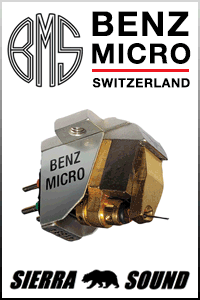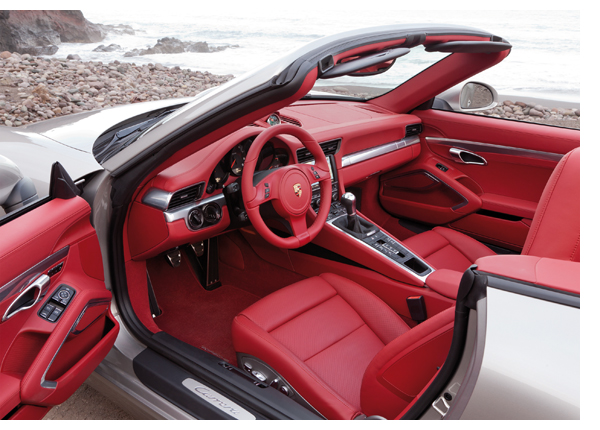Porsche 911 Carrera S Cabriolet Featuring Burmester Audio
 As the new Porsche 911 Carrera S Cabriolet rockets out of an exit ramp at just under 150 kilometers/hour (about 90mph), with its 3.8-liter powerplant shrieking towards the 7900 RPM redline, I take full advantage of the 400 horsepower at my disposal and, for the moment, ignore the Burmester sound system installed in the vehicle. And, thanks to Porsche’s latest version of PASM (Porsche Advanced Stability Management), I’m not thinking about the rear end of the car wanting to step out and join the front end—as it could have easily done with my 1983 911 SC. Nope. I feel like Speed Racer.
As the new Porsche 911 Carrera S Cabriolet rockets out of an exit ramp at just under 150 kilometers/hour (about 90mph), with its 3.8-liter powerplant shrieking towards the 7900 RPM redline, I take full advantage of the 400 horsepower at my disposal and, for the moment, ignore the Burmester sound system installed in the vehicle. And, thanks to Porsche’s latest version of PASM (Porsche Advanced Stability Management), I’m not thinking about the rear end of the car wanting to step out and join the front end—as it could have easily done with my 1983 911 SC. Nope. I feel like Speed Racer.
A quick blip of the throttle, and another rapid gear change via the paddle shifters conveniently mounted on the steering wheel (my test vehicle is equipped with the 7-speed PDK transmission), nudge the speedo past 200kph and grab the attention of local police parked on the side of the highway. Fortunately, they just blink their headlights to see if I’ll get the message. Communiqué received: It’s time for some Skynyrd. In Terminator mode, cranking “Give me Three Steps,” I briefly entertain raising the cops’ dander, knowing their van no match for the 911’s 187 mph terminal velocity. As Hunter S. Thompson used to say, “Any day is a good day for a high speed chase.”
The PDK transmission allows drivers to shift faster than they can with a standard manual transmission, yet offers the convenience and smoothness of an automatic in tight traffic. The different driving modes, instantly available via the centrally located LCD touch panel, directly translate into more driver engagement, with gear changes becoming more positive and upshifts going to the redline with ease. Sport Plus, the most aggressive mode (utilizing Porsche’s “racing circuit” program), holds the car in the chosen gear just like a pure manual even as it permits faster changes than a manual. Then there’s the “launch control” option, which cuts .2 sec from the manual cars’ 0-62mph time. Playing Gran Turismo 4 does not prepare you for the 911 Carrera S experience.
I suspect the Sport Plus mode sacrifices fuel economy, but it’s as easy to inter thoughts of fuel conservation as it is to bury the tachometer needle. If you have the cash to afford one of these, buy a Prius for a daily driver. For those laden with eco-guilt, Porsche engineers note this is the most efficient 911 ever made, and can actually yield 30mpg when driven gingerly on the highway.
Back to Burmester
It’s time to concentrate on the real reason I’m visiting Spain’s Gran Canaria Island: to evaluate the Burmester Mobile Audio System. Slowing back down to the posted 60kph squelches the wind noise to a whisper and is more conducive to serious listening. The Supreme Beings of Leisure’s “I’ll Be Good Tomorrow” fits my brush with Johnny Law, and seizes upon the enormous bass capability in this system. Top-down motoring takes its toll on mobile music listening, with bass response suffering the most, as it’s cancelled out by road, air, and tire noise. When funneled through the 12 speakers integrated into the 911’s cabin, the 821-watt Burmester system easily overpowers nature.
Granted, environmental noise cuts dynamic range, and yet, something major is gained by removing the 911’s soft top. Doing so takes only 13 seconds and can be performed at speeds up to 60kph/40mph. Cabin resonances disappear, and if you’ve ever taken your speakers out into your backyard, you know what I’m talking about.
Tooling around at boulevard speeds, the 911 Cabriolet sounds like a gigantic pair of Stax Electrostatic headphones on wheels. And what a comfy listening room it is. Make no mistake, Porsche has not abandoned its racing heritage chasing creature comfort. The current 911 is almost 60kg (27 pounds) lighter than the previous generation. And it now sports an interior on par with anything coming out of the Aston Martin factory. I can’t think of a better place to sit and listen to music.
The stereo system utilizes the same driver and AMT tweeters Burmester employs in its home speaker systems. When I asked Dieter Burmester how he’s able to achieve such a high level of performance for the $5,500 upcharge, he makes it clear that eliminating the stunning casework definitely factors into the savings, but that the big cost cutter stems from the power supply. “We put a lot into our power supplies. They are an integral part of the Burmester amplifiers, and make up a large part of the build cost. The car already has DC on tap, making our job easier in that respect.”
A standard stereo mode is available, along with a surround mode and an “adaptive” mode that adjusts the DSP controls on the fly in relation to driving environment—i.e. top up, top down, etc. Neither Porsche nor TONEAudio suggest fiddling with the stereo system while driving. Come to a complete stop before changing modes, or have your co-pilot handle the task.
The stereo mode sounds a bit more natural with the top up, throwing a good stereo image, which can be optimized from the control screen. The other two modes feel better suited to topless conditions. Surround mode throws the soundstage way out beyond the cabin boundaries, while the adaptive mode is more intimate. Listening to the Fleet Foxes’ debut, I felt as if I were onstage attending an episode of “VH1 Storytellers,” with Robin Pecknold singing in the passenger seat and the rest of the band surrounding me. The effect is truly psychedelic, and this car too much fun. I suddenly realize my 105-horsepower Fiat 500 Sport and Bose system is going to suck when I get back home.
The Best Transformer Ever
The 911 Carrera S Cabriolet presents a constant challenge: enjoy music or spirited driving. There’s only a small speed window in which you can relish both. Of course, you could always put the top up. Nah. Unfortunately, most of Burmester’s hard work in optimizing the sound system flies out the window as the speed increases. But the symphony provided by the flat six is equally engaging, especially when zooming through a tunnel with the top down.
While the Porsche 911 Carrera S features multiple adjustments for the Burmester hi-fi system and the PASM, it really boils down to just two: thrill and chill, both equally enticing. – Jeff Dorgay








